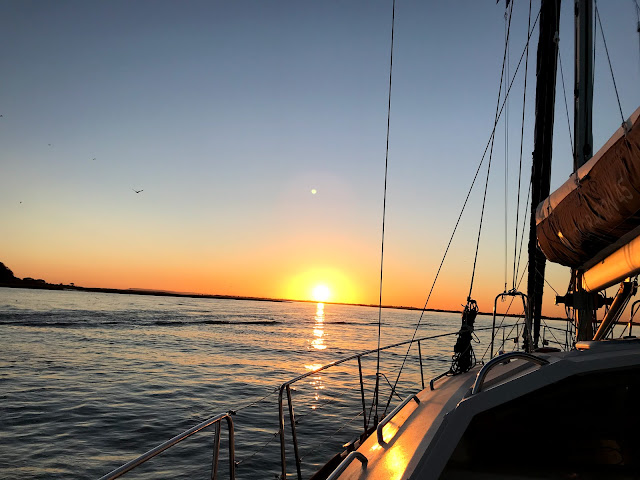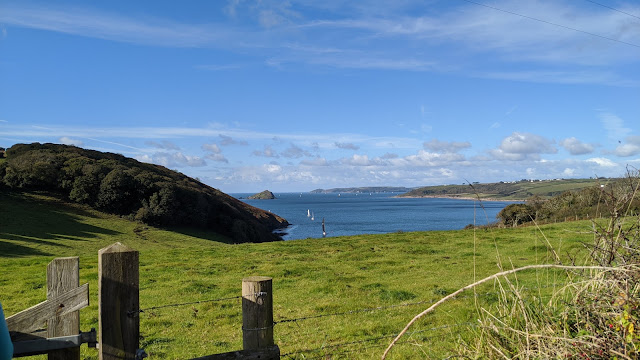Catching up on the Solstice
Tomorrow is the northern hemisphere winter solstice, and that seems like a good time to at least slightly catch up on what Katy, Idril and I have been up to since my last real blog post back in mid-October.
We left Dartmouth, where we had been pinned down by weather, on October 20th, rounding Portland Bill well to its south, and arrived at Studland Bay around sunset, anchoring just outside of Poole rather than trying to enter a shallow, heavily trafficked and unfamiliar estuary in the dark.
 |
| "Old Harry" and "Old Harry's Wife" rocks, at the south end of Studland Bay |
The next morning we motored around the corner to the south side of Brownsea Island and anchored, spending two nights before setting off for the Solent.
 |
| Brownsea Island is known as the birthplace of Scouting. Troops from all over the world visit , often leaving signs. |
The Solent is an iconic sailing region on the south coast of England, the starting point of the biennial Fastnet Race, and chock full of harbors and anchorages to explore. It lies between the south coast of England and the Isle of Wight, and our approach from Poole took us past The Needles, a set of rocks defining the western edge of the narrow channel west of the Isle of Wight.
We picked up a mooring in Newtown Creek, on the south side of the Isle of Wight. We stayed for three nights, again waiting out weather, and exploring Newtown and Shalfleet.
From Newtown we sailed back to mainland England and Buckler's Hard, on the Beaulieu River. Buckler's Hard was an important wooden shipyard in the 18th and 19th centuries, and is surrounded by New Forest (new in the 11th century...). I found it to be a wonderful, flattish bicycling territory! :-)
After several more days of waiting out weather at Buckler's Hard, we sailed back across the strait to the Isle of Wight, this time to East Cowes - the actual starting point of the Fastnet race.
Our final port of call in the Solent was Chichester Marina, which is behind a lock a long way up a somewhat scary inlet with large over-falls if you approach at anything other than slack tide. We left East Cowes on the morning of November 3rd and arrived at the marina in the early afternoon - in time to get in a walk into the actual town of Chichester. It was a long walk, and we didn't get back to the marina until well after dark.
 |
| Wing-on-wing towards Chichester |
 |
| The upside of rain showers |
The next day we learned that the U.K. was about to re-impose a COVID-19 lockdown. It was hard to get reliable information as to what this meant for us, so we went out on the morning of November 4th for a nice bike ride near the marina.
Upon our return to the marina, we learned that, if we stayed, we would be confined to the boat for the entire lockdown - a real problem, as we were not suitably provisioned. Further, it appeared that the marina lock would be shut down for lockdown that night, leaving us TRAPPED in Chichester Marina -- and the U.K. -- for at least a month. We really needed to get the boat back to Cherbourg for the post-launch checkout, so on very short notice, we prepped the boat for sea and set off for Cherbourg, regardless of the weather and tide state.
 |
| Leaving Chichester at sunset, about to enter the Solent |
Luckily, the winds were very mild (we had planned on waiting for stronger northeast winds, expected in a couple of days), so we had a gentle, if slow, sail across the Channel to Cherbourg.
 |
| Daybreak over the English Channel |
 |
| Sailing on just the gennaker |
 |
| It doesn't get much better... |
 |
| Almost to Cherbourg |
Our AIS was broadcasting our location, and shortly after we entered French waters we were contacted on VHF radio by signal station Barfleur, asking us our destination, and (essentially) "What are you doing entering French waters when France is locked down and not accepting leisure craft?" Luckily, we could (legitimately) explain that we were headed for Cherbourg for repairs and winter service, which are valid reasons for arriving in France.
SO - here we are. We have spent the past 6 weeks or so doing boat maintenance chores, trying to get our long-stay visas extended (they expire on January 1, 2021), and working with Garcia (actually, Grand Large Services) on the issues to be dealt with on the boat. Cherbourg is a very reasonable place for us to be. We know the town well (from our stay here this previous winter and spring), the weather is acceptable (rainy, but not too cold), and the incidence of COVID-19 is (at least for now) low.
On Monday, January 4th, we will sail the boat to the commercial dock in Tourlaville, and GLS will haul the boat and have it taken to the Garcia yard for the work that must be done. We have reserved a nice Airbnb east of town (in Bretteville) for the 2+ weeks that the boat will be on the hard. It will be weird not living on the boat; since we moved aboard in June, it's really become our home.
Our tentative plans are to spend the winter in France (hopefully further south), then sail to Ireland and Scotland in the spring. At the end of the summer we will head south, reaching the Canary Islands in October or November, to be ready to cross the Atlantic to the Caribbean in December/January -- a year behind our original schedule.
This year has certainly been very different from what we had planned, but I can't say that I'm especially unhappy about it. We have the boat, we've been learning how to live aboard, meeting nice people, and seeing new places. COVID-19 has certainly whacked our plans for a loop - but isn't that true for everyone? We're still healthy, we still have each other and our family and friends, and life goes on.
I wish all of you a Happy Hanukkah, joyous winter solstice, Merry Christmas, and much better 2021.
-- Jerry (and Katy)
More pictures (some duplication from album to album):













































